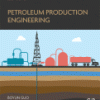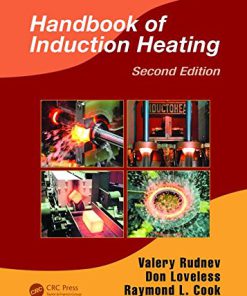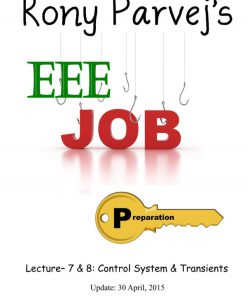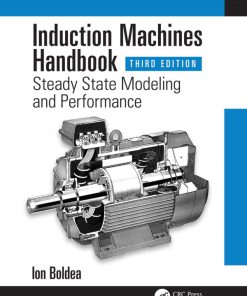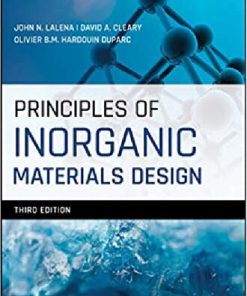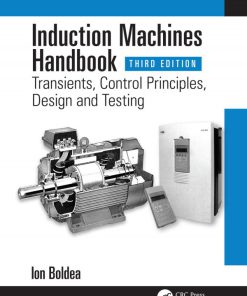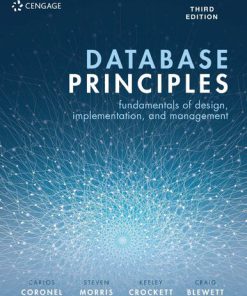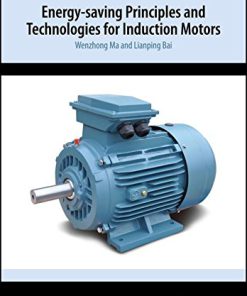Induction Machines Handbook Transients Control Principles Design and Testing 3rd Edition by Ion Boldea 1000056822 9781000056822
$50.00 Original price was: $50.00.$25.00Current price is: $25.00.
Induction Machines Handbook: Transients, Control Principles, Design and Testing 3rd Edition by Ion Boldea – Ebook PDF Instant Download/DeliveryISBN: 1000056822, 9781000056822
Full download Induction Machines Handbook: Transients, Control Principles, Design and Testing 3rd Edition after payment.
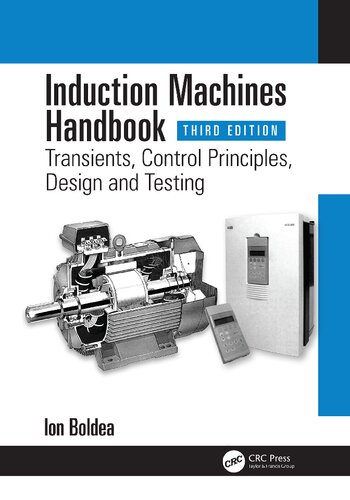
Product details:
ISBN-10 : 1000056822
ISBN-13 : 9781000056822
Author: Ion Boldea
Induction Machines Handbook: Transients, Control Principles, Design and Testing presents a practical up-to-date treatment of intricate issues with induction machines (IM) required for design and testing in both rather constant- and variable-speed (with power electronics) drives. It contains ready-to-use industrial design and testing knowledge, with numerous case studies to facilitate a thorough assimilation of new knowledge. Individual Chapters 1 through 14 discuss in detail the following: Three- and multiphase IM transients Single-phase source IM transients Super-high-frequency models and behavior of IM Motor specifications and design principles IM design below 100 kW and constant V1 and f1 IM design above 100 kW and constant V1 and f1 IM design principles for variable speed Optimization design Single-phase IM design Three-phase IM generators Single-phase IM generators Linear induction motors Testing of three-phase IMs Single-phase IM testing Fully revised and amply updated to add the new knowledge of the last decade, this third edition includes special sections on Multiphase IM models for transients Doubly fed IMs models for transients Cage-rotor synchronized reluctance motors Cage-rotor PM synchronous motor Transient operation of self-excited induction generator Brushless doubly fed induction motor/generators Doubly fed induction generators with D.C. output Linear induction motor control with end effect Recent trends in IM testing with power electronics Cage-PM rotor line-start IM testing Linear induction motor (LIM) testing This up-to-date book discusses in detail the transients, control principles, and design and testing of various IMs for line-start and variable-speed applications in various topologies, with numerous case studies. It will be of direct assistance to academia and industry in conceiving, designing, fabricating, and testing IMs (for the future) of various industries, from home appliances, through robotics, e-transport, and renewable energy conversion.
Induction Machines Handbook: Transients, Control Principles, Design and Testing 3rd table of contents:
Chapter 1 Induction Machine Transients
1.1 Introduction
1.2 The Phase-Coordinate Model
1.3 The Complex Variable Model
1.4 Steady State by the Complex Variable Model
1.5 Equivalent Circuits for Drives
1.6 Electrical Transients with Flux Linkages as Variables
1.7 Including Magnetic Saturation in the Space-Phasor Model
1.8 Saturation and Core Loss Inclusion into the State-Space Model
1.9 Reduced-Order Models
1.9.1 Neglecting Stator Transients
1.9.2 Considering Leakage Saturation
1.9.3 Large Machines: Torsional Torque
1.10 The Sudden Short Circuit at Terminals
1.11 Most Severe Transients (So Far)
1.12 The abc-d-q Model for PWM Inverter-Fed IMs
1.12.1 Fault Conditions
1.13 First-Order Models of IMs for Steady-State Stability in Power Systems
1.14 Multimachine Transients
1.15 Subsynchronous Resonance (SSR)
1.16 The M/Nr Actual Winding Modelling for Transients
1.17 Multiphase Induction Machines Models for Transients
1.17.1 The Six-Phase Machine
1.17.2 The Five-Phase Machine
1.18 Doubly Fed Induction Machine Models for Transients
1.19 Cage-Rotor Synchronized Reluctance Motors
1.20 Cage Rotor PM Synchronous Motors
1.21 Summary
References
Chapter 2 Single-Phase IM Transients
2.1 Introduction
2.2 The d-q Model Performance in Stator Coordinates
2.3 Starting Transients
2.4 The Multiple-Reference Model for Transients
2.5 Including the Space Harmonics
2.6 Summary
References
Chapter 3 Super-High-Frequency Models and Behaviour of IMs
3.1 Introduction
3.2 Three High-Frequency Operation Impedances
3.3 The Differential Impedance
3.4 Neutral and Common Mode Impedance Models
3.5 The Super-High-Frequency Distributed Equivalent Circuit
3.6 Bearing Currents Caused by PWM Inverters
3.7 Ways to Reduce PWM Inverter Bearing Currents
3.8 Summary
References
Chapter 4 Motor Specifications and Design Principles
4.1 Introduction
4.2 Typical Load Shaft Torque/Speed Envelopes
4.3 Derating due to Voltage Time Harmonics
4.4 Voltage and Frequency Variation
4.5 Specifying Induction Motors for Constant V and f
4.6 Matching IMs to Variable Speed/Torque Loads
4.7 Design Factors
4.7.1 Costs
4.7.2 Material Limitations
4.7.3 Standard Specifications
4.7.4 Special Factors
4.8 Design Features
4.9 The Output Coefficient Design Concept
4.10 The Rotor Tangential Stress Design Concept
4.11 Summary
References
Chapter 5 IM Design below 100 KW and Constant V and f (Size Your Own IM)
5.1 Introduction
5.2 Design Specifications by Example
5.3 The Algorithm
5.4 Main Dimensions of Stator Core
5.5 The Stator Winding
5.6 Stator Slot Sizing
5.7 Rotor Slots
5.8 The Magnetization Current
5.9 Resistances and Inductances
5.9.1 Skewing Effect on Reactances
5.10 Losses and Efficiency
5.11 Operation Characteristics
5.12 Temperature Rise
5.13 Summary
References
Chapter 6 Induction Motor Design above 100 KW and Constant V and f (Size Your Own IM)
6.1 Introduction
6.2 Medium-Voltage Stator Design
6.2.1 Main Stator Dimensions
6.2.2 Stator Main Dimensions
6.2.3 Core Construction
6.2.4 The Stator Winding
6.3 Low-Voltage Stator Design
6.4 Deep Bar Cage Rotor Design
6.4.1 Stator Leakage Reactance Xsl
6.4.2 The Rotor Leakage Inductance Lrl
6.5 Double-Cage Rotor Design
6.5.1 Working Cage Sizing
6.6 Wound Rotor Design
6.6.1 The Rotor Back Iron Height
6.7 IM with Wound Rotor-Performance Computation
6.7.1 Magnetization mmfs
6.7.2 The Airgap Fg
6.7.3 The Stator Teeth mmf
6.7.4 Rotor Tooth mmf (Ftr) Computation
6.7.5 Rotor Back Iron mmf Fcr (as for the Stator)
6.7.6 The Rotor Winding Parameters
6.7.7 The Rotor Slot Leakage Geometrical Permeance Coefficient Ksr
6.7.8 Losses and Efficiency
6.7.9 The Machine Rated Efficiency ηn
6.7.10 The Rated Slip Sn (with Short-Circuited Slip Rings)
6.7.11 The Breakdown Torque
6.8 Summary
References
Chapter 7 Induction Machine Design for Variable Speed
7.1 Introduction
7.2 Power and Voltage Derating
7.3 Reducing the Skin Effect in Windings
7.3.1 Rotor Bar Skin Effect Reduction
7.4 Torque Pulsations Reduction
7.5 Increasing Efficiency
7.6 Increasing the Breakdown Torque
7.7 Wide Constant Power Speed Range via Voltage Management
7.8 Design for High- and Super-High-Speed Applications
7.8.1 Electromagnetic Limitations
7.8.2 Rotor Cooling Limitations
7.8.3 Rotor Mechanical Strength
7.8.4 The Solid Iron Rotor
7.8.5 21 kW, 47,000 rpm, 94% Efficiency with Laminated Rotor
7.9 Sample Design Approach for Wide Constant Power Speed Range
7.9.1 Solution Characterization
7.10 Summary
References
Chapter 8 Optimization Design Issues
8.1 Introduction
8.2 Essential Optimization Design Methods
8.3 The Augmented Lagrangian Multiplier Method (ALMM)
8.4 Sequential Unconstrained Minimization
8.5 Modified Hooke–Jeeves Method
8.6 Genetic Algorithms
8.6.1 Reproduction (Evolution and Selection)
8.6.2 Crossover
8.6.3 Mutation
8.6.4 GA Performance Indices
8.7 Summary
References
Chapter 9 Single-Phase IM Design
9.1 Introduction
9.2 Sizing the Stator Magnetic Circuit
9.3 Sizing the Rotor Magnetic Circuit
9.4 Sizing the Stator Windings
9.5 Resistances and Leakage Reactances
9.6 The Magnetization Reactance xmm
9.7 The Starting Torque and Current
9.8 Steady-State Performance around Rated Power
9.9 Guidelines for a Good Design
9.10 Optimization Design Issues
9.11 Two-Speed PM Split-Phase Capacitor Induction/Synchronous Motor
9.11.1 Pole-Changing and Using Permanent Magnets
9.11.2 The Chosen Geometry
9.11.3 Experimental Results
9.11.4 Theoretical Characterization: Steady-State Model and Optimal Design
9.11.5 Steady-State Model
9.11.6 Optimal Design
9.11.7 2D FEM Investigations
9.11.8 Proposed Circuit Model for Transients and Simulation Results
9.11.9 Conclusion
9.12 Summary
References
Chapter 10 Three-Phase Induction Generators
10.1 Introduction
10.2 Self-Excited Induction Generator (SEIG) Modelling
10.3 Steady-State Performance of SEIG
10.4 The Second-Order Slip Equation Model for Steady State
10.5 Steady-State Characteristics of SEIG for Given Speed and Capacitor
10.6 Parameter Sensitivity in SEIG Analysis
10.7 Pole Changing SEIGs
10.8 Unbalanced Steady-State Operation of SEIG
10.8.1 The Delta-Connected SEIG
10.8.2 Star-Connected SEIG
10.8.3 Two Phases Open
10.9 Transient Operation of SEIG
10.10 SEIG Transients with Induction Motor Load
10.11 Parallel Operation of SEIGs
10.12 The Doubly Fed IG (DFIG) Connected to the Grid
10.12.1 Basic Equations
10.12.2 Steady-State Operation
10.13 DFIG Space-Phasor Modelling for Transients and Control
10.14 Reactive-Active Power Capability of DFIG
10.15 Stand-alone DFIGs
10.16 DSW Cage and Nested-Cage Rotor Induction Generators
10.17 DFIG with Diode-Rectified Output
10.18 Summary
References
Chapter 11 Single-Phase Induction Generators
11.1 Introduction
11.2 Steady-State Model and Performance
11.3 The d-q Model for Transients
11.4 Expanding the Operation Range with Power Electronics
11.5 Summary
References
Chapter 12 Linear Induction Motors
12.1 Introduction
12.2 Classifications and Basic Topologies
12.3 Primary Windings
12.4 Transverse Edge Effect in Double-Sided LIM
12.4.1 The Transverse Edge Effect Correction Coefficients
12.5 Transverse Edge Effect in Single-Sided LIM
12.6 A Technical Theory of LIM Longitudinal End Effects
12.7 Longitudinal End-Effect Waves and Consequences
12.8 Secondary Power Factor and Efficiency
12.9 The Optimum Goodness Factor
12.10 Linear Flat Induction Actuators (No Longitudinal End Effect)
12.10.1 The Equivalent Circuit
12.10.2 Performance Computation
12.10.3 Normal Force in Single-Sided Configurations
12.10.4 A Numerical Example
12.10.5 Design Methodology by Example
12.10.6 The Ladder Secondary
12.11 Tubular LIAs
12.11.1 A Numerical Example
12.12 Short-Secondary Double-Sided LIAs
12.13 Linear Induction Motors for Urban Transportation
12.13.1 Specifications
12.13.2 Data from Past Experience
12.13.3 Objective Functions
12.13.4 Typical Constraints
12.13.5 Typical Variables
12.13.6 The Analysis Model
12.13.7 Discussion of Numerical Results
12.14 Transients and Control of LIMs
12.15 LIM Control with Dynamic Longitudinal End Effect
12.16 Electromagnetic Induction Launchers
12.17 Summary
References
Chapter 13 Testing of Three-Phase IMs
13.1 Loss Segregation Tests
13.1.1 The No-Load Motor Test
13.1.2 Stray Losses from No-Load Overvoltage Test
13.1.3 Stray Load Losses from the Reverse Rotation Test
13.1.4 The Stall Rotor Test
13.1.5 No-Load and Stall Rotor Tests with PWM Converter Supply
13.1.6 Loss Measurement by Calorimetric Methods
13.2 Efficiency Measurements
13.2.1 IEEE Standard 112–1996
13.2.2 IEC Standard 34–2
13.2.3 Efficiency Test Comparisons
13.2.4 The Motor/Generator Slip Efficiency Method
13.2.5 The PWM Mixed-Frequency Temperature Rise and Efficiency Tests (Artificial Loading)
13.2.5.1 The Accelerating-Decelerating Method
13.2.5.2 The PWM Dual Frequency Test
13.3 The Temperature-Rise Test via Forward Short-circuit (FSC) Method
13.4 Parameter Estimation Tests
13.4.1 Parameter Calculation from No-Load and Standstill Tests
13.4.2 The Two-Frequency Standstill Test
13.4.3 Parameters from Catalogue Data
13.4.4 Standstill Frequency Response Method
13.4.5 The General Regression Method for Parameters Estimation
13.4.6 Large IM Inertia and Parameters from Direct Starting Acceleration and Deceleration Data
13.5 Noise and Vibration Measurements: From No Load to Load
13.5.1 When On-Load Noise Tests Are Necessary?
13.5.2 How to Measure the Noise On-Load
13.6 Recent Trends in IM Testing
13.7 Cage-PM Rotor Line-Start IM Testing
13.8 Linear Induction Motor (LIM) Testing
13.9 Summary
References
Chapter 14 Single-Phase IM Testing
14.1 Introduction
14.2 Loss Segregation in Split-Phase and Capacitor-Start IMs
14.3 The Case of Closed Rotor Slots
14.4 Loss Segregation in Permanent Capacitor IMs
14.5 Speed (Slip) Measurements
14.6 Load Testing
14.7 Complete Torque–Speed Curve Measurements
14.8 Summary
People also search for Induction Machines Handbook: Transients, Control Principles, Design and Testing 3rd:
the induction machines design handbook
the induction machines design handbook pdf
types of induction machines
induction booklet examples
induction machine price
Tags: Induction Machines, Transients, Control Principles, Design, Testing, Ion Boldea
You may also like…
Cookbooks
Engineering
Induction Machines Handbook-Steady State Modeling and Performance 3rd Edition Ion Boldea (Author)
Uncategorized
Computers - Databases
Engineering



